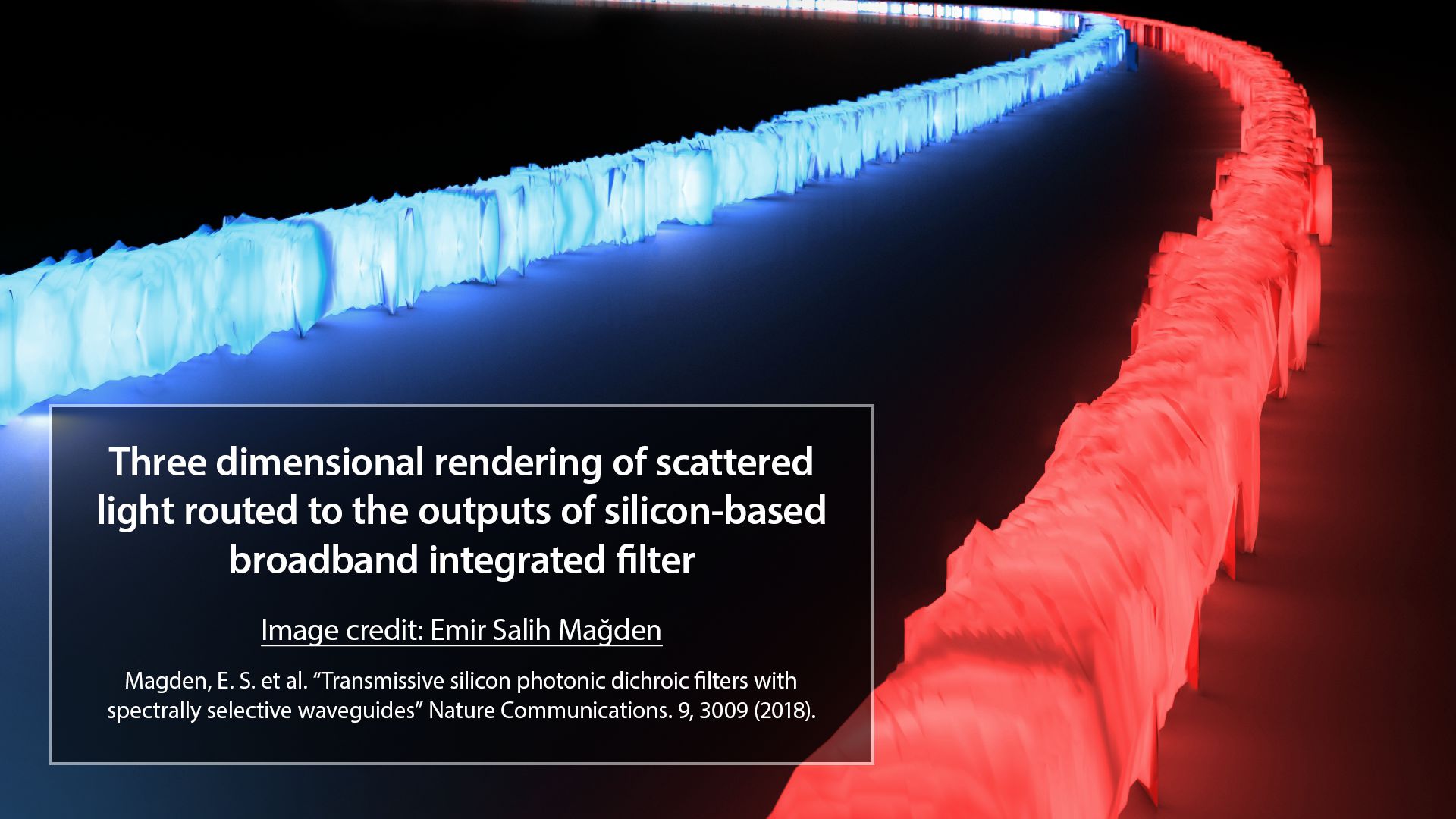Our work on integrated broadband optical filters, now published in Nature Communications, provides a novel design and demonstration of optical filters that can simultaneously achieve broadband response and a sharp roll-off. The lead author of the paper describing integrated filter design and measurements is Prof. Emir Salih Mağden, along with colleagues from MIT’s Research Laboratory of Electronics. The article is featured on MIT’s homepage on August 3rd 2018.
Pictured is a 3D-render of scattered light from the integrated waveguides comprising the filter, captured at two different wavelengths directed towards the two separate output ports of the filter.
An integrated filter is a nanophotonic device that separates or combines a specific portion of the input optical signal into one or more outputs. The specific filters we present in the article are true examples of integrated long-pass/short-pass optical filters, with only a single cutoff in between. The pass bands demonstrate inherently low-loss and flat-top transmission characteristics which are highly desired for efficient filter operation. The roll-off between the pass and stop bands is achieved by phase-matching between asymmetric waveguides. The phase-matched waveguide pair allows the filter to selectively alter the spatial profile of the light propagating through the device, depending on the input wavelength. With the use of slowly-varying transitions between the waveguides, the demonstrated filters are expected to operate with more than an octave of optical bandwidth. These integrated filter designs represent a class of devices equivalent to the commonly used RC (resistor-capacitor) circuits in electronics that perform a similar filtering functions for the domain of radio-frequency signals. With this wide operation bandwidth, the filters can efficiently separate or combine optical signals from a given frequency up to over twice that frequency. This capability is crucial for what is called “f-2f interferometry”, a technique used in stabilizing optical sources by combining a part of the optical spectrum with the corresponding part that has twice the frequency (hence, the name “f-2f”). The demonstrated filters can be used in such interferometers to create extremely precise and stable optical or radio frequency signals. These precise signals can enable better signal quality in cell phones, superior positioning and navigation capabilities, integrated display systems that include many colors of light, and accurate detection of many fast phenomena including spectroscopy of various atoms or molecules as well as gravitational waves.
The article is being covered by media outlets around the world. We would like to thank Rob Matheson from MIT News for the original story linked below.
“On-chip optical filter processes wide range of light wavelengths”
- MIT News (story by Rob Matheson)
- Phys.org
- ScienceDaily
- EurekAlert!
- Nanowerk
- SciTechDaily
- Tech Explorist
- R&D Magazine
- ECN Maganize
- Industrial Safety and Security Source
- MWee
- Photonics.com (among editor’s picks)
- NTBoxMag
- Opli
- Communications of the ACM
Journal Reference: Emir Salih Magden, Nanxi Li, Manan Raval, Christopher V. Poulton, Alfonso Ruocco, Neetesh Singh, Diedrik Vermeulen, Erich P. Ippen, Leslie A. Kolodziejski, Michael R. Watts. Transmissive silicon photonic dichroic filters with spectrally selective waveguides. Nature Communications, 2018; 9 (3009) DOI: 10.1038/s41467-018-05287-1
Araştırmacılar kablosuz bağlantılarda çekim gücünü artırabilecek çip üzerinde geniş bantlı optik filtre icat etti
Entegre geniş bant optik filtreler üzerindeki çalışmalarımız, 1 Ağustos 2018’de dünyanın en iyi akademik dergilerinden birisi olarak kabul edilen Nature Communications’da yayınlandı. Baş yazarlığı Doktor Öğretim Üyesi Emir Salih Mağden tarafından yapılan makalede, metrenin milyonda biri kadar küçük boyutlara sahip entegre filtre tasarım ve ölçümleri MIT’nin Elektronik Araştırma Laboratuvarı’ndan araştırmacılarla beraber sunulmuştur. Makalemiz 3 Ağustos 2018’de MIT internet sitesi ana sayfasında kapak fotoğrafı olarak seçildi.
Görselde, tasarlanan filtrenin iki ayrı çıktısına yönlendirilen farklı dalga boylarındaki ışığın, silisyum ışık kanallarından saçılması üç boyutlu olarak resmedilmiştir.
Makalede anlatılan optik filtreler çeşitli dalga boylarında yüksek hassasiyette ve stabil sinyaller üretilmesini sağlamaktadır. Bu üretilen sinyaller ile cep telefonu ve tablet gibi kablosuz cihazlarda çekim gücü ve navigasyon kabiliyetini artırılabilmekte, görüntü sistemlerinde ise farklı renklerde lazer ışığının verimli şekilde bir araya getirilmesini sağlamaktadır. Elde edilen stabil sinyaller ile ayrıca yerçekimi dalgalarının kaydedilmesinde ve çeşitli atom veya moleküllerde saniyenin katrilyonda biri mertebesinde sürelerde meydana gelen fiziksel olayların incelenmesinde ilerlemelerin kaydedileceği öngörülmektedir.
Makale dünya çapında medya kuruluşları tarafından ele alınmaktadır:
- MIT News
- Phys.org
- ScienceDaily
- EurekAlert!
- Nanowerk
- SciTechDaily
- Tech Explorist
- R&D Magazine
- ECN Maganize
- Industrial Safety and Security Source
- MWee
- Photonics.com (editörün seçtiği haberler arasında)
- NTBoxMag
- Opli
- Communications of the ACM
Referans: Emir Salih Mağden, Nanxi Li, Manan Raval, Christopher V. Poulton, Alfonso Ruocco, Neetesh Singh, Diedrik Vermeulen, Erich P. Ippen, Leslie A. Kolodziejski, Michael R. Watts. Transmissive silicon photonic dichroic filters with spectrally selective waveguides. Nature Communications, 2018; 9 (3009) DOI: 10.1038/s41467-018-05287-1

